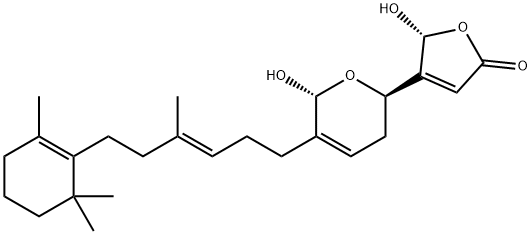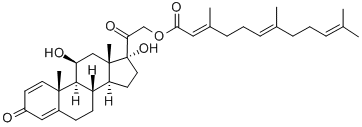FARNESAL
Synonym(s):3,7,11-Trimethyl-2,6,10-dodecatrienal
- CAS NO.:19317-11-4
- Empirical Formula: C15H24O
- Molecular Weight: 220.35
- MDL number: MFCD00038089
- EINECS: 242-957-9
- SAFETY DATA SHEET (SDS)
- Update Date: 2024-12-18 14:15:32

What is FARNESAL?
Occurrence
Reportedly present in tomato, ginger and cardamom.
The Uses of FARNESAL
Farnesal was used in the synthesis of sesquiterpene nanaimoal.
The Uses of FARNESAL
Farnesone is s useful building block for organic synthesis
What are the applications of Application
Farnesal is an unsaturated long chain aldehyde for proteomics research
Preparation
Reportedly prepared in a patented process by reaction of farnesol with diethyl ether in the presence of a catalyst.
Definition
ChEBI: Farnesal is a farnesane sesquiterpenoid and an enal.
Synthesis Reference(s)
Synthetic Communications, 20, p. 3125, 1990 DOI: 10.1080/00397919008051535
General Description
Farnesal has been reported as specific lipid substrate for aldo-keto reductase 1B10 (AKR1B10). The incubation of farnesol with the protoplast of Botryococcus braunii B race strain leads to the formation of farnesal and 3-hydroxy-2,3-dihydrofarnesal.
Properties of FARNESAL
| Boiling point: | 126-129 °C3.5 mm Hg(lit.) |
| Density | 0.909 g/mL at 25 °C(lit.) |
| refractive index | n |
| FEMA | 4019 | 3,7,11-TRIMETHYL-2,6,10-DODECATRIENAL |
| Flash point: | >230 °F |
| storage temp. | Amber Vial, Refrigerator |
| solubility | Chloroform (Sparingly), Methanol (Sparingly) |
| form | Oil |
| color | Pale Yellow to Yellow |
| Odor | floral minty |
| JECFA Number | 1228 |
| BRN | 1723427 |
| Stability: | Light Sensitive |
| EPA Substance Registry System | 2,6,10-Dodecatrienal, 3,7,11-trimethyl- (19317-11-4) |
Safety information for FARNESAL
| Signal word | Warning |
| Pictogram(s) |
 Exclamation Mark Irritant GHS07 |
| GHS Hazard Statements |
H315:Skin corrosion/irritation H319:Serious eye damage/eye irritation H335:Specific target organ toxicity, single exposure;Respiratory tract irritation |
| Precautionary Statement Codes |
P261:Avoid breathing dust/fume/gas/mist/vapours/spray. P264:Wash hands thoroughly after handling. P264:Wash skin thouroughly after handling. P271:Use only outdoors or in a well-ventilated area. P280:Wear protective gloves/protective clothing/eye protection/face protection. P302+P352:IF ON SKIN: wash with plenty of soap and water. P305+P351+P338:IF IN EYES: Rinse cautiously with water for several minutes. Remove contact lenses, if present and easy to do. Continuerinsing. |
Computed Descriptors for FARNESAL
New Products
Tert-butyl bis(2-chloroethyl)carbamate (S)-3-Aminobutanenitrile hydrochloride N-Boc-D-alaninol N-BOC-D/L-ALANINOL 3-(2,4-Dimethoxybenzyl)dihydropyrimidine-2,4(1H,3H)-dione 7-Bromo-1H-indazole N-octanoyl benzotriazole 3,4-Dibenzyloxybenzaldehyde 4-Hydrazinobenzoic acid Electrolytic Iron Powder Fmoc-Val-Cit-PAB 1,1’-CARBONYLDIIMIDAZOLE R-2-BENZYLOXY PROPIONIC ACID 4-HYDROXY BENZYL ALCOHOL 1,1’-CARBONYLDI (1,2-4 TRIAZOLE) S-2-CHLORO PROPIONIC ACID (2-Hydroxyphenyl)acetonitrile 4-Bromopyrazole 5-BROMO-2CYANO PYRIDINE 5,6-Dimethoxyindanone 5-broMo-2-chloro-N-cyclopentylpyriMidin-4-aMine 1-(4-Methylphenylsulfonyl)-1H-1,2,3-benzotriazole 1-(2-Chlorobenzyl)-4-nitro-1H-pyrazole 1-(2-Nitrophenyl)-4-phenylpiperazineRelated products of tetrahydrofuran








You may like
-
 Farnesal, mixture of isomers CAS 19317-11-4View Details
Farnesal, mixture of isomers CAS 19317-11-4View Details
19317-11-4 -
 55441-95-7 2 2-BIS(2-HYDROXYETHOXY)-1 1-BINAPHTHYL 99%View Details
55441-95-7 2 2-BIS(2-HYDROXYETHOXY)-1 1-BINAPHTHYL 99%View Details
55441-95-7 -
 Ste-Glu-AEEA-AEEA-OSUView Details
Ste-Glu-AEEA-AEEA-OSUView Details
1169630-40-3 -
 1446013-08-6 Fmoc-His-Aib-OH TFA 98%View Details
1446013-08-6 Fmoc-His-Aib-OH TFA 98%View Details
1446013-08-6 -
 127464-43-1 99%View Details
127464-43-1 99%View Details
127464-43-1 -
 Chloro Uracil 99%View Details
Chloro Uracil 99%View Details
1820-81-1 -
 2-ETHYLPYRIDINE 100-71-0 99%View Details
2-ETHYLPYRIDINE 100-71-0 99%View Details
100-71-0 -
 13162-05-5 99%View Details
13162-05-5 99%View Details
13162-05-5